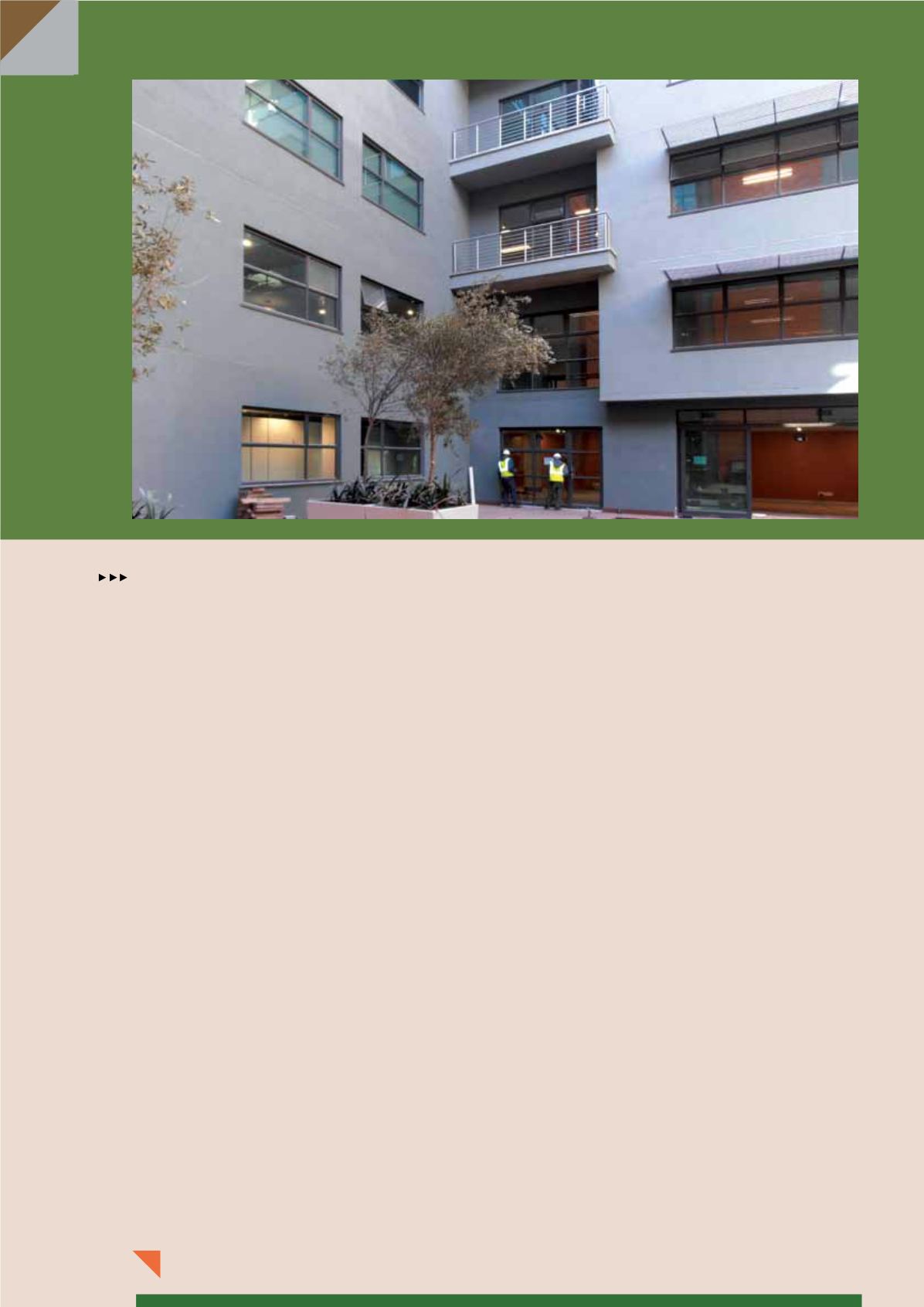
June 2013
CONSTRUCTION WORLD
44
project profile
energy solutions. Growthpoint has Aurecon
to oversee the green building elements of
the development.
Pre-commissioning, commissioning and
quality monitoring will be undertaken for
the mechanical, electrical, hydraulic, and fire
services of the project in accordance with
the correct Chartered Institute of British
Engineers codes. And, to ensure efficient
running of all these systems each subcon-
tractor will sign a monthly tuning contract
ensuring that for one year after practical
completion, the building is tuned and tested.
Aurecon will also compile a Building Users
Guide for the building owner and occupants,
to ensure that tenants enjoy the full benefits
of a green building.
At the same time, an Environmental
Management Plan is being implemented
and independently monitored to ensure
compliance. This includes Murray & Roberts
Buildings ensuring that more than 50% of
all construction waste from the site is
recycled to mitigate the amount of waste
destined for landfill.
Ventilation will be improved by an HVAC
system that provides outside air at a rate
which is 100% higher than that prescribed
by SANS 10400-O. The building design also
makes provision for good levels of daylight
to enter the building for occupant wellbeing
and to reduce the need for artificial lighting.
The lighting system includes high frequency
ballasts in fluorescent luminaires for energy
efficiency and increased lamp life.
Paints, carpets and sealants have been
specified as low VOC (volatile organic com-
pounds) to mitigate sick building syndrome,
while exhaustlouvers will enable the extrac-
tion of indoor pollutants from printing and
copying areas.
All measures have been taken to create the
most efficient lighting design possible, in
terms of fittings and distribution, achieving
an average of 360 Lux with no areas exceed-
ing 400 Lux. Lighting power density for 95%
of the total usable area has been designed to
be 2W/squaremetre/100 Lux. Each enclosed
space and zone smaller than 100 m
2
will be
individually switched for lighting.
Occupancy and absent detection systems
will control lighting usage in dedicatedmeet-
ing and conference rooms. Basement parking
lighting will be luminaires fitted with two
stage electronic ballast with default setting
at 20% of 100% lighting output, with a mo-
tion sensor which will activate to 100% on
motion detection and reset to 20% after a
pre-selected time period.
Two 10 kW output (3 kW input) air-to-
water type heat pumps will generate hot
water, saving energy compared to a conven-
tional geyser.
In terms of transport, the development
team has aimed to reduce the number of
parking spaces by at least 25% lower than
the maximum local planning allowance
applicable to the project to encourage the
use of public transport facilities. Five percent
of the parking bays are dedicated to alterna-
tive fuel and hybrid vehicles, with preferred
parking locations. One of these parking bays
will also be equipped with an electric plug
point for electric vehicles. Cyclist facilities,
bicycle parking bays, showers and lockers
have been incorporated into the design.
Water efficient fittings and fixtures,
including dual flush toilets and waterless
urinals will be installed to achieve significant
water savings. Condensate recovery from
the HVAC system will also be collected and
reused, resulting in decreased potable water
usage. A 36 000 litre water collection tank
will harvest rainwater that will be collected
for toilet flushing.
Water consumption is further mitigated
with each floor-plate of the building being
less than 2 500 square metres and harness-
ing the passive design principle of provid-
ing openable window sections on floors,
specifically for smoke ventilation. This has
eliminated the need for office sprinklers, with
only themain lobby of the building provided
with three sprinkler-drencher heads per floor.
Water meters linked to the building man-
agement system will provide the building
manager with information on water usage
and leak detection.
The landscape design incorporates initia-
tives such as moisture sensors, indigenous
plant species, night-time irrigation, mulch in
plant bed areas and the use of water reten-
tion additives, to reduce irrigation demand.
A dedicated recycling waste and general
waste storage area will be provided for sepa-
ration and recycling of office waste. Concrete
mixes, supplied by AfriSam, reduce Portland
cement quantities by 30% on average by the
substitution of fly ash into the concrete mix,
while 90%of all steel used has been specified
to have a post-consumer recycled content
greater than 60%. The total cost of PVC is
being reduced by 30%, through replacement
with alternative plumbing and storm water
piping materials, such as HDPE, while timber
products are being obtained from sustain-
able, recycled or re-used sources. To reduce
transportation emissions, 20%of the contract
value is being sourced fromwithin 400 kmof
the site.
To reduce emissions, refrigerants have
been specified to have an ozone depleting
potential of zero.
C ST CTIO W L


